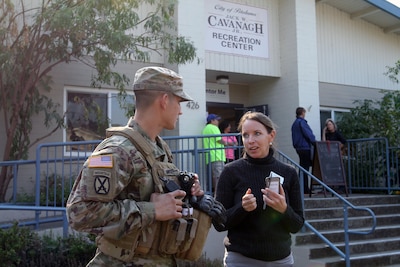By Army Staff Sgt. Edward Siguenza, 69th Public Affairs
Detachment
PETALUMA, Calif., Oct. 16, 2017 — The presence of the
California Army National Guard was enough for Deborah L. Dalton to put things
into perspective.
As thousands of people flee the Northern California fires,
hundreds landed at the Cavanagh Recreation Center’s 12,000 square-foot facility
where Dalton serves as executive director. The center quickly became an
evacuation site.
The facility normally caters to at-risk youth, where caring
adults mentor youngsters into becoming better people, but Dalton and her
12-member administrative staff had to shift gears on the fly. Teachers became
hostesses, staffers became waiters and janitors. Bus after bus rolled into the
compound, unloading fire victims. Cots and sleeping essentials filled the
Cavanagh facility beyond its capacity.
“Oh Lord, it became so overwhelming,” Dalton explained.
“We’ve never done this before. We’re not trained to be an evacuation center. I
could have cried until [the California National Guard] rolled up in [their]
humvees.”
Her years mentoring troubled youth kicked in, she said. As
evacuees settled in, the potential for disorder filled the center. Dalton
noticed tension among the outsiders -- young adults, in particular -- and the
task of avoiding conflict was going to be left in the hands of the center’s
staff.
Just outside, several California Army National Guard
vehicles pulled up. Local authorities were also on hand, but they are
supporting hundreds of other sites. So members of the California Army National
Guard’s 270th and 870th Military Police companies stepped forward to help. For
several days, the soldiers and staff have worked together to uphold a system
where order and peace overrule the fear and unknown.
‘We’re Here to Help’
Dalton said the MPs have been a big help. “Now we know where
to route people. Now we have a better idea of what to do. I love you people,
and I’m a fan,” she said of the guardsmen.
The soldiers work around the clock and don’t just provide
security. They help transport food and other items, they move, load and unload
vehicles and they talk to the victims. Many of the guardsmen are bilingual.
Some guardsmen, such as Army Staff Sgt. Timothy Barrera, with the 270th MP
Company, play games with the kids.
“We can’t break our rules, but if there are things that we
can help to get done, we do it,” Barrera said. “There’s a really good feeling
here. People keep offering us stuff, but we keep telling them, ‘We’re here to
help you.’”
Raging fires in Northern California have killed more than 30
people, scorched hundreds of thousands of acres of land, and displaced several
thousands, per the California Forestry and Fire Protection website in late September
and early October. Several of the California National Guard’s military police
units were assigned to assist victims and supporters at various shelters,
centers and churches in Northern California cities.
“You know what it is? I think it’s just the fact that
they’re here gives us peace of mind,” Dalton said. “We just weren’t prepared
for something like this. This center has never seen anything like it. With [the
guardsmen] here, now we can concentrate on what needs to be done.”









